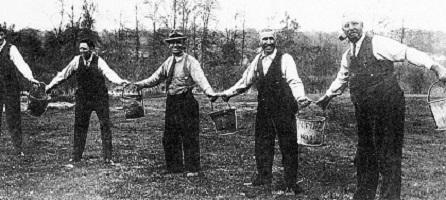Bucket Brigades & Human Chains
The earliest fire extinguishers were human chains moving buckets of water, hand-to-hand, from a well or water resource to the site of the fire.
200 B.C.E. – Ctesibius’ Water Pump
The first-ever recorded water pump in 200 B.C. by Ctesibius of Alexandria, “the father of pneumatics.”
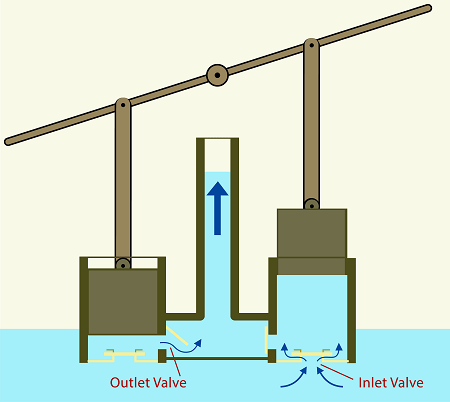
Water Pump Designed by Ctesibius
The principle of the pump was relatively simple: Water flows into the inlet valve of a one-way cylinder when the piston is raised. The water is then forced out another one-way valve when the piston is forced down. The water then flows into a delivery pipe. A second cylinder is added alongside the first, with both pistons attached to the main lever for greater efficiency. When one piston goes up, the other piston goes down. During the upward movement of the piston, the cylinder functions as a suction pump, bringing water in through a rising pipe. During the downward direction, the piston forces the water sucked from the pump cylinder into the main pipe.
15th Century – Leonardo da Vinci’s Kitchen Nightmare
In the 15th century, Leonardo da Vinci created a super-oven for his patron, Ludovico Sforza, in advance of a celebration. Leonardo understood the danger such an oven could cause, so he created a sprinkler system as a safeguard. As part of Leonardo’s super-oven system, he also built a system of conveyor belts to make the cooking and baking process more efficient. In Leonardo da Vinci’s 15th century version of Kitchen Nightmares, everything went wrong during his patron’s big party. The conveyor belt began running too fast. The cooking area staff could not stay up to date with the flow, and a small fire burst out in the kitchen. A fire broke out in the kitchen, and the sprinkler system flooded and washed away all the food and a good part of the kitchen.
A good summary of Leonardo’s Kitchen Nightmare incident is retold in the following video:
1723 – Ambrose Godfrey – First Documented Fire Extinguisher
The first documented fire extinguisher was patented in England in 1723 by the famous English chemist Ambrose Godfrey. Godfrey’s device was a container of fire-extinguishing fluid enclosing another small container of gunpowder. A series of fuses connected the container of gunpowder. When the main fuse was lit, the gunpowder exploded and scattered the solution.
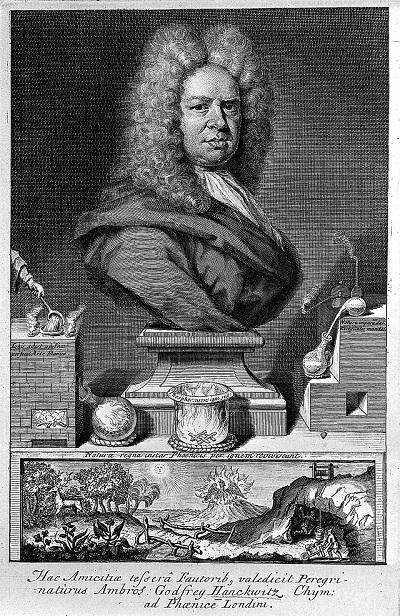
Ambrose Godfrey-Hanckwitz FRS (1660 – 15 January 1741), also known as Gottfried Hankwitz, sometimes written as Hanckewitz, or Ambrose Godfrey as was his preference, was a British phosphorus manufacturer and apothecary who was born in Germany. Godfrey had migrated to London, England to live in 1679. He was one of the first phosphorus manufacturers and the most successful in his time. He invented and patented a device that resembled a fire extinguisher.
1818 – George William Manby – First Modern Fire Extinguisher
Around the 1810s, the British Captain and developer George William Manby created a mobile pressurized fire extinguisher. The device could release approximately three gallons (13.6 liters) of potassium carbonate (called pearl ash) onto a fire. Manby’s copper container contained the potassium carbonate solution within compressed air.
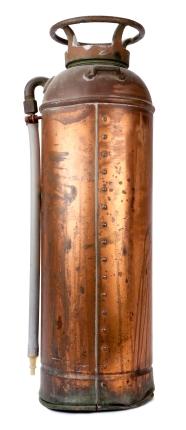
This is an antique fire extinguisher claimed to have been designed by Manby, but the author of this article could not confirm this with a primary source at the time of publication.
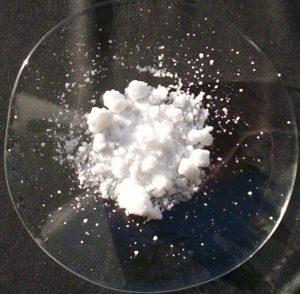
Potassium Carbonate
1866 – Francois Carlier Patents the Soda-Acid Extinguisher in France.
Francois Carlier, invented a different version of Manby’s fire extinguisher. His version is called the soda-acid extinguisher. Carlier decided not to use compressed air, and instead used a device that contained two containers underneath a canister of water. Tartaric acid from one container was mixed with a sodium bicarbonate solution in another container. These two substances would mix and then produce CO2 propellant gas.
1881 – Almon M. Granger Patents the Soda-Acid Extinguisher in the U.S.
Almon M. Granger patented another version of the soda-acid extinguisher in the United States in 1881. Granger’s version used the reaction of mixing sodium bicarbonate solution with sulphuric acid to generate pressurized water. A small vessel was suspended in the cylinder containing sulphuric acid. There were two different versions. In one version, a plunger broke the vessel of acid. A lead stopple was released in another version that held the vessel closed. When the acid was mixed with the bicarbonate solution, the carbon dioxide gas was expelled. This pressurized the water. The pressurized water was then pushed through a nose or hose from the canister.
1881 – Read & Campbell of England Create the Cartridge-Operated Extinguisher
The cartridge-operated extinguisher was created in 1881 by Read & Campbell. Their cartridge-operated extinguisher used water or water-based solutions. A short time later Read & Campbell created a carbon tetrachloride version. They named this version the Petrolex and advertised it for automotive use.
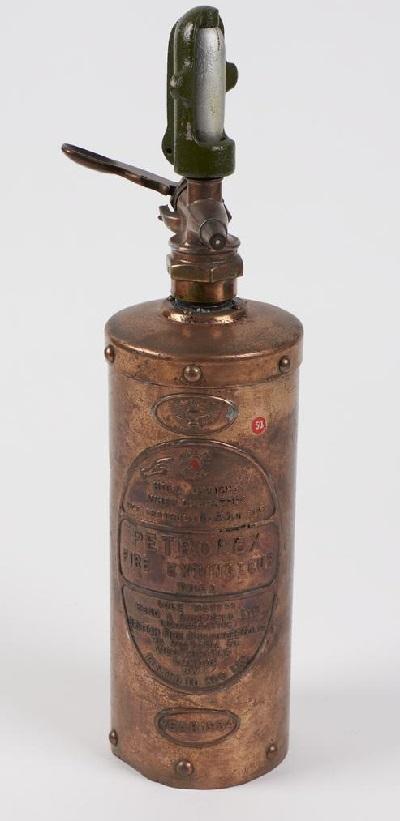
Read & Campbell’s Petrolex
1904 – Aleksandr Loran Invents the Chemical Foam Extinguisher in Russia
In Russia, in 1904, Aleksandr Loran invented the chemical foam extinguisher. The extinguisher was similar to the soda-acid fire extinguisher but worked differently. The main vessel contained a solution of sodium bicarbonate. There was an inner container that had a solution of aluminum sulfate. When the two substances were combined — by inverting the extinguisher — the two substances reacted to make a frothy foam substance and carbon dioxide. The carbon dioxide gas then discharged the foam from the extinguisher.
1910 – 1911 – The Pyrene Manufacturing Company Invents a Fire Extinguisher Using Carbon Tetrachloride
The Pyrene Manufacturing Company invented a fire extinguisher using carbon tetrachloride, CTC, to extinguish fires in 1910. In 1911 they patented a small, portable extinguisher that used the chemical. Carbon tetrachloride works by creating fumes that exclude oxygen when exposed to fire. The device was an unpressurized chrome or brass vessel with a hand pump. The CTC vaporized and extinguished the flames by interfering with the chemical reaction. The CTC extinguisher worked well for liquid and electrical fires and was often used in automobiles. Carbon tetrachloride fire extinguishers were taken off the market in the late 1950s because carbon tetrachloride is toxic, and deaths occurred in confined spaces. Carbon tetrachloride is also a suspected human carcinogen.
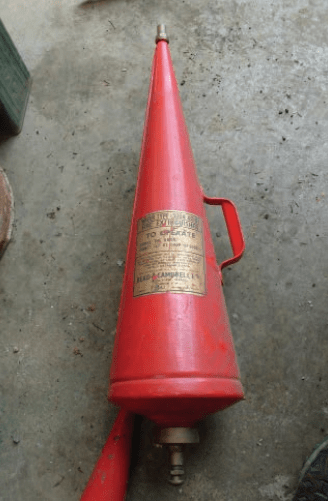
The Pyrene CTC Extinguisher
1924 – The Carbon Dioxide Fire Extinguisher Created in the U.S. by the Walter Kidde Company
The carbon dioxide (CO2) extinguisher was created in 1924. It was a tall metal cylinder containing CO2 with a wheel valve and a woven brass, cotton covered hose, with a composite funnel-like horn as a nozzle. The carbon dioxide (CO2) extinguisher was invented by the Walter Kidde Company in response to a request for an electrically non-conductive chemical for extinguishing the previously difficult-to-extinguish fires in telephone switchboards. It consisted of a tall metal cylinder containing 7.5 pounds (3.4 kg) of CO2 with a wheel valve and a woven brass, cotton covered hose, with a composite funnel-like horn as a nozzle. CO2 is still popular today as it is an ozone-friendly clean agent and is used heavily in film and television production to extinguish burning stuntmen. Carbon dioxide extinguishes fire mainly by displacing oxygen.
1928 – DuGas Creates the Cartridge-Operated Dry Chemical Fire Extinguisher
DuGas (later ANSUL) developed the cartridge-operated dry chemical extinguisher. This device was a copper cylinder with an internal CO2 cartridge. The user turned a wheel valve on top to puncture the cartridge and then squeezed a lever on the valve at the end of the hose. These actions discharged the chemical. This extinguisher used sodium bicarbonate specially treated with chemicals to render it free-flowing and moisture-resistant. This was the first agent available for large-scale three-dimensional liquid and pressurized gas fires, but remained largely a specialty type until the 1950s, when smaller dry chemical units were sold for home use.
1940s – Germany Invents the Liquid Chlorobromomethane (CBM) Fire Extinguisher for Aircraft
Germany invented the liquid chlorobromomethane (CBM) for use in aircraft. It was more effective and slightly less toxic than carbon tetrachloride and was used until 1969. In the 1940’s, Germany invented the liquid chlorobromomethane (CBM) for use in aircraft. It was more effective and slightly less toxic than carbon tetrachloride and was used until 1969. Methyl bromide was discovered as an extinguishing agent in the 1920s and was used extensively in Europe. It is a low-pressure gas that works by inhibiting the chain reaction of the fire and is the most toxic of the vaporizing liquids used until the 1960s. The vapor and combustion by-products of all vaporizing fluids were highly toxic and could cause death in confined spaces.
The 1950s and 1960s
In this period, significant developments in dry chemical agents led to the introduction of potassium bicarbonate (Purple K), monoammonium phosphate (ABC), potassium chloride (Super K), and urea potassium (Monnex). Potassium chloride and urea potassium-based dry chemicals are not common in the U.S. Dry chemicals are nonpoisonous. Still, either the acidic-based (ABC) or alkaline-based (Regular or Purple K) chemicals could be an irritant if inhaled. Dry chemical is not recommended for electrical equipment or aircraft fires because the substances may damage the equipment beyond repair.
Monoammonium phosphate (ABC) is the dry chemical extinguishing agent used on class A, class B, and class C fires.
ABC dry chemical was first used in Europe in the 1950s. Super-K was first used in the early 1960s. Purple-K was first used by the US Navy in the late 1960s.
The 1970s
Halon 1211 came over to the United States from Europe, where it had been used since the late 40s or early 50s. Halon 1301 was developed by DuPont and the US Army in 1954. Both 1211 and 1301 work by inhibiting the chain reaction of the fire and, in the case of Halon 1211, cooling class A fuels as well. Halon is still in use today but is falling out of favor for many uses, due to its environmental impact.
Today
Monoammonium phosphate (ABC) is the most commonly used extinguishing agent in most fire extinguishers used today.


